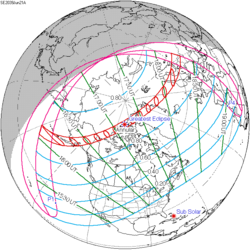| Annular eclipse | |
| Gamma | 0.8312 |
|---|---|
| Magnitude | 0.9454 |
| Maximum eclipse | |
| Duration | 245 s (4 min 5 s) |
| Coordinates | 78°54′N102°06′W / 78.9°N 102.1°W |
| Max. width of band | 365 km (227 mi) |
| Times (UTC) | |
| Greatest eclipse | 17:12:54 |
| References | |
| Saros | 147 (24 of 80) |
| Catalog # (SE5000) | 9595 |
An annular solar eclipse will occur at the Moon's ascending node of orbit on Tuesday, June 21, 2039, [1] with a magnitude of 0.9454. A solar eclipse occurs when the Moon passes between Earth and the Sun, thereby totally or partly obscuring the image of the Sun for a viewer on Earth. An annular solar eclipse occurs when the Moon's apparent diameter is smaller than the Sun's, blocking most of the Sun's light and causing the Sun to look like an annulus (ring). An annular eclipse appears as a partial eclipse over a region of the Earth thousands of kilometres wide. Occurring about 2 days after apogee (on June 19, 2039, at 16:55 UTC), the Moon's apparent diameter will be smaller. [2]
Contents
- Images
- Eclipse timing
- Places experiencing annular eclipse
- Places experiencing partial eclipse
- Eclipse details
- Eclipse season
- Related eclipses
- Eclipses in 2039
- Metonic
- Tzolkinex
- Half-Saros
- Tritos
- Solar Saros 147
- Inex
- Triad
- Solar eclipses of 2036–2039
- Saros 147
- Metonic series
- Tritos series
- Inex series
- References
- External links
Annularity will be visible from parts of Alaska, northern Canada, Greenland, Norway, Sweden, southern Finland, Estonia, Latvia, northeastern Lithuania, western Russia, and Belarus. A partial eclipse will be visible for parts of Hawaii, North America, Europe, Northwest Africa, and northern Russia.
This eclipse will start only a few hours after the northern solstice and most of the path will go across areas with midnight sun. For mainland Norway, Sweden and Belarus, it will be the first central solar eclipse since June 1954.






































































































